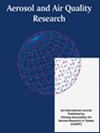光氧化还原催化氧化氮在au增强表面等离子体共振ZnSn(OH)6微立方体上的分解
IF 2.5
4区 环境科学与生态学
Q3 ENVIRONMENTAL SCIENCES
引用次数: 0
摘要
空气污染是当今最受关注的问题之一,因为它对生物和环境产生不利影响。其中,一氧化氮(NO)是温室效应、酸雨和呼吸系统疾病的主要原因。因此,寻找一种低成本、环保、高效的光催化脱除NO的技术是十分必要和迫切的。本文采用金纳米粒子(Au:cZHS)修饰ZnSn(OH) 6微立方(cZHS)催化剂,增强了表面等离子体共振(SPR)光氧化催化降解NO的能力。这项工作证明了SPR对ZHS光氧化还原性能的贡献。其中,在金纳米粒子的SPR作用下,cZHS的光氧化还原效率显著提高,Au:cZHS的光氧化还原效率达到75%,约为cZHS的4倍。此外,对其他氮种的生成、二氧化氮(NO 2)的转化以及材料的可重复利用进行了理论和实验的计算和讨论。另一方面,通过捕获实验和随时间变化的电子自旋共振(ESR),也清楚地研究了自由基的贡献和寿命。本研究使读者对SPR对chzs光催化性能的影响有了更清晰的认识,为今后的相关研究提供了必要的依据。本文章由计算机程序翻译,如有差异,请以英文原文为准。
Photoredox-Catalyzed Decomposition of Nitric oxide over Au-Enhanced Surface Plasmon Resonance ZnSn(OH)6 Microcubes
Air pollution is one of the most concerning issues today because of its adverse effects on living organisms and the environment. Therein, nitric oxide (NO) is the leading cause of the greenhouse effect, acid rain, and respiratory diseases. Therefore, discovering a low-cost, environmentally friendly, highly efficient photocatalysis technique to remove NO is necessary and urgent. In this work, the ZnSn(OH) 6 microcubes (cZHS) catalyst was decorated with golden nanoparticles (Au:cZHS) to enhance the photoredox-catalyzed degradation of NO under solar light by surface plasmon resonance (SPR). This work demonstrated the contribution of SPR to the photoredox performance of the ZHS. Herein, the photoredox efficiency of the cZHS increased dramatically under the effecting of SPR from the golden nanoparticles, the photoredox efficiency of the Au:cZHS reached 75%, about four times higher than that of cZHS. In addition, the generation of other nitrogen species, nitrogen dioxide (NO 2 ) conversion, and the reusability of the materials are calculated and discussed carefully by theory and experiment. On the other hand, the contribution and lifespan of radicals are also investigated clearly with trapping experiments and time-dependent electron spin resonance (ESR). This study provided the reader with a clear understanding of the SPR effect on the photocatalytic performance of cZHS, which may be necessary for future related studies.
求助全文
通过发布文献求助,成功后即可免费获取论文全文。
去求助
来源期刊

Aerosol and Air Quality Research
ENVIRONMENTAL SCIENCES-
CiteScore
8.30
自引率
10.00%
发文量
163
审稿时长
3 months
期刊介绍:
The international journal of Aerosol and Air Quality Research (AAQR) covers all aspects of aerosol science and technology, atmospheric science and air quality related issues. It encompasses a multi-disciplinary field, including:
- Aerosol, air quality, atmospheric chemistry and global change;
- Air toxics (hazardous air pollutants (HAPs), persistent organic pollutants (POPs)) - Sources, control, transport and fate, human exposure;
- Nanoparticle and nanotechnology;
- Sources, combustion, thermal decomposition, emission, properties, behavior, formation, transport, deposition, measurement and analysis;
- Effects on the environments;
- Air quality and human health;
- Bioaerosols;
- Indoor air quality;
- Energy and air pollution;
- Pollution control technologies;
- Invention and improvement of sampling instruments and technologies;
- Optical/radiative properties and remote sensing;
- Carbon dioxide emission, capture, storage and utilization; novel methods for the reduction of carbon dioxide emission;
- Other topics related to aerosol and air quality.
 求助内容:
求助内容: 应助结果提醒方式:
应助结果提醒方式:


